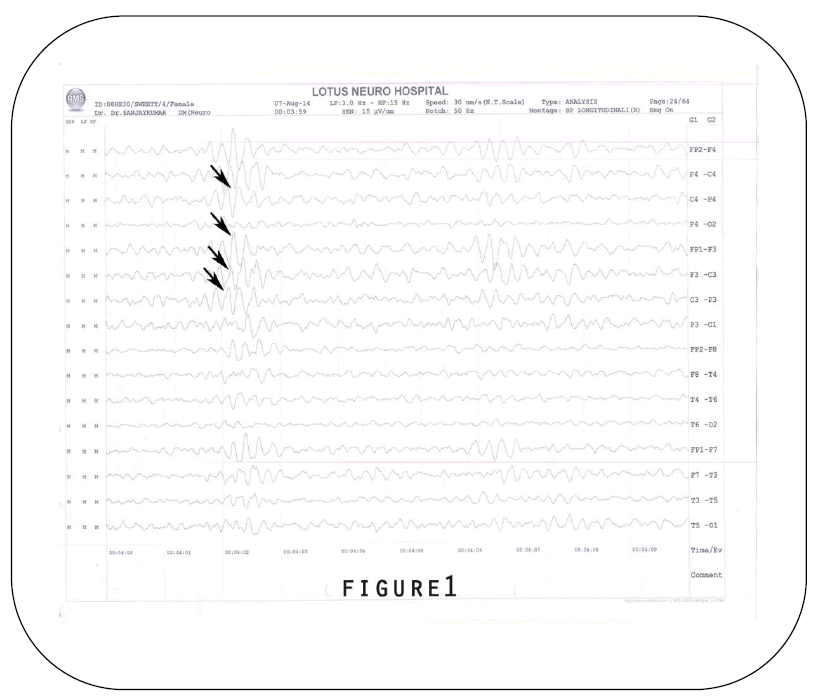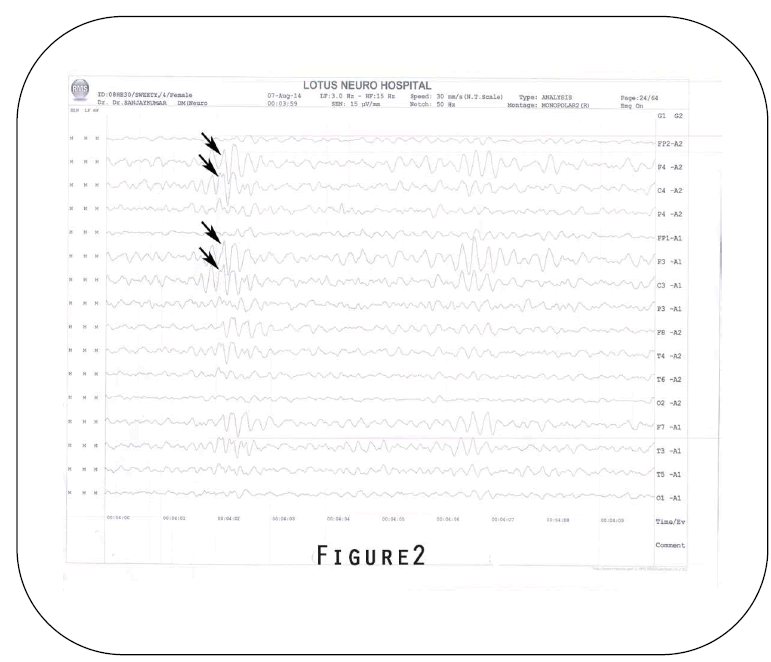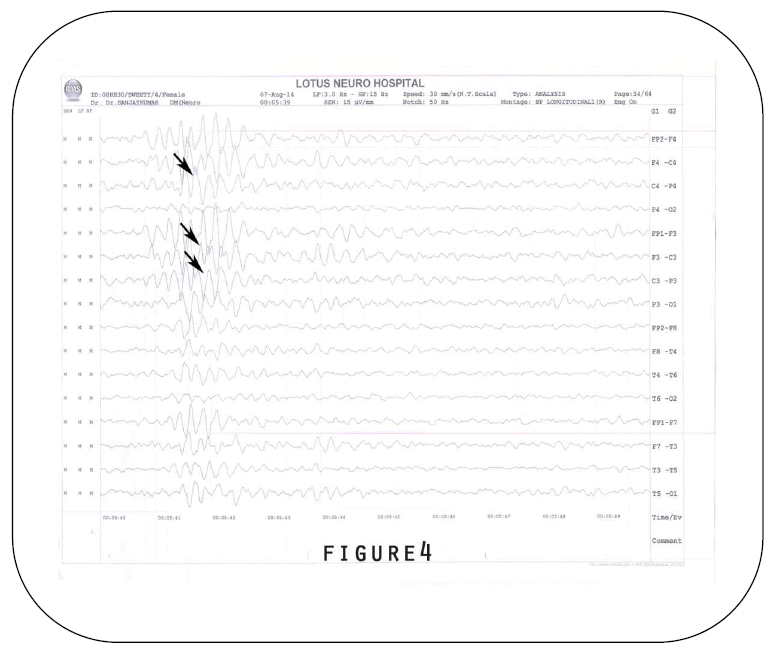Keywords
Benign rolandic epilepsy, Centro temporal spikes, Abnormal behaviour.
Introduction
Epilepsy is common neurological
disorder of the childhood. It is characterised
by recurrent, episodic, paroxysmal,
involuntary clinical events associated with
abnormal electrical activity form neurons.
Benign Rolandic Epilepsy is also called as
Benign Epilepsy with Centro Temporal
Spikes or Sylvian Epilepsy. It is the most
common epilepsy of childhood affecting
previously healthy children aged 4-13 years
with an incidence of 10-20 per 1,00,000
children under age of 15. [1]
It is characterised by twitching,
numbness or tingling of face or tongue and
may interfere with speech and cause
drooling of saliva. Seizures are focal and
involve unilateral sensory motor function of
face, speech arrest and hypersalivation is
seen. Consciousness is generally maintained
although seizure may progress to become
hemiconvulsive or generalised tonic clonic.
Atypical forms may present with
atypical manifestation such as onset at early
age, developmental delay, learning difficulties, other seizure types, atypical
EEG abnormalities. [2-4]
The same EEG pattern was later
correlated with a common form of focal
childhood epilepsy, then called mid
temporal epilepsy, characterized by
hemifacial and oro pharyngeal ictal
symptoms and a favorable prognosis.
Because of the localization of the ictal
events to centro temporal area, Lombroso
proposed the term sylvian seizures in 1967.
In the same year, Loiseau and colleagues
presented a series of 122 children with what
they called a particular form of epilepsy in
childhood, stressing its benign character and
highlighting clinical and EEG features.
Atypical and not so benign evolutions have
been reported in some patients with this
form of epilepsy. [2] This form of epilepsy is
now called benign childhood epilepsy with
centrotemporal spikes and is placed in the
group of idiopathic localization-related
epilepsies in the International Classification
of Epilepsies and Epileptic Syndromes. [1]
About 79 children with benign rolandic
epilepsy were reported who together had
more than 900 seizures over an 8.5 year
period. There were no significant injuries.
A particular EEG pattern with
migratory spikes originating over Rolandic
(Centro temporal or Mid temporal) region
was first reported in 1952 by Gastaut and in
1954 by Gibbs et al. In 1958 the first
description of clinical features in association
with peculiarities of EEG in those children
was published by Nayrac.
Case Report
A four year female child presented to
casuality with history of abnormal behaviour
since afternoon. The child was born to nonconsanguinous
parents, first in order of
birth, with other sibling normal. No family
history of similar complaints and any
neurological diseases. She was born at full term through normal vaginal delivery
without any perinatal problems. Child was
immunised till date.
The Neuro Psychomotor
development of the patient was globally
normal. Child had presented with aggressive
behaviour two months back and a
presumptive diagnosis of ADHD was made
by a Neuro Psychiatrist and child was on
regular treatment with Sodium Valproate 2.5
ml twice daily and then Haloperidol 0.25 mg
twice daily was started two days before she
presented to our hospital. The child
suddenly developed abnormal behaviour
characterised by starring look, not able to
swallow food or drink water, drooling of
saliva, not able to walk and not able to speak
to any one for about five minutes. When the
child presented to the casuality in the
evening she was active and interactive but
suddenly developed ophisthotonus posture
with head turning to one side for about two
minutes. There was no loss of consciousness
during the episode and no post ictal amnesia.
There was no history of fever. The child had
a head injury 6 months back. There was no
history of vomiting, headache, convulsions
or loss of consciousness after the head
injury.
On Neurological examination the
power was Grade 5 and tone was normal in
all the limbs. The reflexes were normal and
signs of meningeal irritation were absent.
EEG showed Fronto Centro Parietal
epileptiform discharges. CT Scan was
normal. With the history and EEG findings,
diagnosis of Benign Rolandic Epilepsy was
considered and treatment with Sodium
Valproate continued with appropriate dose
and there were no fresh episodes.
Discussion
Benign Rolandic epilepsy represented
9.6–10.3 percent of all childhood epilepsies,
determined at presentation and 2 years later.
In its pure form, it is not associated with structural lesions or severe neurocognitive
deficits. [5]
Familial EEG studies suggest that the
benign epilepsy with centro temporal spikes
follows an autosomal dominant mode of
inheritance with high but incomplete
penetrance and age dependant expression.
Loiseau and Douche provided 5 criteria for
diagnosis of benign childhood epilepsy with
centro temporal spikes: [6]
1. Onset between 2-13 yrs age
2. Absence of neurological or intellectual
deficit before onset
3. Partial seizures with motor signs, frequent
association with somato sensory
symptoms or precipitated by sleep.
4. A spike focus located in centro temporal
(Rolandic) area with normal background
activity on the interictal EEG.
5. Spontaneous remission during
adolescence.
When awake, children experience
brief focal twitching of one side of face,
anarthria, drooling of saliva and parasthesia of
face, gums, tongue or inner cheeks. These
manifestations may be followed by
hemiclonic movements or hemitonic
posturing. These diurnal seizures are simple
and consciousness is preserved. Post ictal
weakness of the involved face and limbs may
occur.
Most of the children have purely
nocturnal seizures that usually become
secondarily generalised. In such cases, the
focal onset of seizures usually is not
observed, but parents are alerted by sounds of
secondarily generalised convulsion.
The typical rolandic seizure is
hemifacial, characterised by a clonic
manifestations involving hemi face,
sometimes preceeded by unilateral parasthesia
involving tongue, lips, gums, cheek; the jerks
can be associated with a lateral tonic
deviation of mouth involving lips and tongue
as well as pharyngeal and laryngeal muscles
and result in anarthria or speech arrest and drooling of saliva due to sialorrhoea and
saliva pooling. [7] The seizure lasts from less
than a minute to 2 minutes can spread to
homolateral arm and rarely leg. [8] Sometimes
the seizures consists of a brief somatosensory
phenomena and in 4.3% cases seizures are
partial complex. [9] Seizure frequency is usually
low.
In children aged 2-5 years Hemi
clonic seizures are more frequent, sometimes
lasting from more than 30 to 60 minutes
followed by transient homolateral deficit
generally not including face. [9] In all case intra
venous Benzodiazepines immediately stop
status even if it is of long duration. No
permanent deficits are seen.
EEG findings are distinctive and
diagnostic in benign focal epilepsy with
central-mid temporal spikes. Focal di or
triphasic sharp waves of almost invariant
morphology occur in the central and mid
temporal regions. Epileptiform discharges
usually are of high voltage (greater than 100
mV), tend to occur in clusters, and activate
dramatically during sleep, when they may
seem almost continuous. In a single EEG,
discharges may be unilateral, but with
prolonged or repeated recordings, they are
almost always bilateral. Lateralization may
switch in serial tracings. Generalized spikes
and spike-and-wave activity occasionally
occur, although more often the spikes are
maximal in either central region and are
simply bisynchronous. No correlation has
been found between EEG findings and
seizure occurrence or frequency. As a rule,
EEG abnormalities are much more impressive
than clinical seizure activity. Indeed, when
central-midtemporal spikes are recorded in
children without seizures, in whom EEGs are
performed for other reasons, typical seizures
eventually develop in only approximately half
of the children. In symptomatic children, EEG
abnormalities persist long after seizures cease.
Thus, EEG does not provide assistance in
making decisions about when or how long to treat. [6] Epileptiform activity may be
augmented in sleep and rarely other focal
discharges or generalised spike waves have
been reported. Three quarters of Rolandic
seizures occur during Non-Rapid eye
movement sleep, often during transition.
Wirrell and colleagues published a
retrospective case series design of 42 children
diagnosed with benign rolandic epilepsy in
whom they looked for atypical features,
which they found in 50% of the patients. [4]
These features do not coincide with those that
we now consider atypical. Since then, more
comprehensive and prospective studies have
focused on the correlation between EEG
abnormalities and neuropsychological
impairments in children with benign rolandic
epilepsy. Atypical features in benign
childhood epilepsy with centrotemporal
spikes can be seen on clinical grounds like
daytime-only seizures, postictal Todd paresis,
prolonged seizures, or even status epilepticus,
or in EEG features like atypical spike
morphology, unusual location, or abnormal
background. [10] Early age of onset of seizures
seems to be one of the most important items
among atypical features. [2]
Treatment is often not necessary due
to low seizure frequency. The first line drug
used is Carbamezepine while Sodium
Valproate, Phenytoin, Gabapentin,
Leviteracitam are also effective.
Prognosis is excellent. Remission
occurs within 2 to 4 yrs of onset nd prior to
the age of 16 yrs and rarely child may
develop language and cognitive dysfunction.
In the present case the child presented at the
age of 4 years which fulfils the age criteria of
Rolandic epilepsy. The symptomatology like
drooling of saliva, unable to talk, abnormal
posturing also suggests that child may have
Rolandic epilepsy but the episodes were only
during day time and the EEG showed Fronto
Centro Parietal epileptiform discharges which
are atypical features of Benign Rolandic
Epilepsy. Figure 1 shows spikes in the right and left central and parietal areas, left frontal
area, and left frontal polar site. Figure 2 shows spikes in right and left frontal and
central areas. Figure 3 shows spikes in left
frontal, central and parietal areas and left
frontal polar site. Figure 4 shows spikes in
right and left central and parietal areas and
left frontal area. So it can be considered as
Atypical form of Benign rolandic epilepsy.
The dose of Sodium Valproate was increased
and the child did not have any fresh episodes.
Acknowledgement
We would like to thank Mr. C
Lakshminarasimha Rao and Dr. V
Suryanarayan Reddy, CAIMS, Karimnagar
for giving for permission to publish the case
report and also Dr. Sanjay, Asst. Professor,
Neurology, Ramesh, Stenographer, Pediatric
department for their valuable help.
Conflict of interest
Nil.
Source of funding
Nil.
References
- Kenneth F Swaiman, Stephen Ashwal, Donna M Ferriero, Nina FS. Swaimans Pediatric Neurology: Principles and Practice. Epilepsy syndromes with focal seizures. 5th Edition. 2012; 54:755-757.
- Fejerman, Natalio, Caraballo, Roberto, Tenembaum, Silvia N. Atypical Evolutions of Benign Localization- Related Epilepsies in Children: Are They Predictable?. Epilepsia. 1 April 2000; 41 (4):380–390.
- Datta A, Sinclair DB. Benign epilepsy of childhood with rolandic spikes: Typical and Atypical variants. Pediatr Neurol. 2007 March; 36(3):141-5.
- Wirrell EC, Camfield PR, Gordon KE, Dooley JM, Camfield CS. Benign rolandic epilepsy: Atypical features are very common. Journal of Child Neurology. 1995; 10(6):455-8.
- S Lundberg, O Eeg Olofsson. Rolandic epilepsy:A challenge in terminology and classification. Eur J Paediatr Neurol. 2003; 7 (5):239-241.
- Loiseau P, Duche B. Benign childhood epilepsy with cantro temporal spikes. Cleve Clin J Med. 1989; 56:17-22.
- Lambroso CT. Sylvian seizures and Mid temporal spike foci in children. Arch Neurol. 17:52-59.
- Loiseau P, Beaussart M. The seizures of benign childhood epilepsy with Rolandic paroxysmal discharges. Epilepsia. 1973; 14:381-389.
- Dalla Bernadina B, Sgro V, Fontana E, Colamaria V, La Salva L. Idiopathic partial epilepsies in children. In: Roger J, Burean M, Dravel C, Dreifuss FE, Perret A, Wolf P. Epileptic syndromes in infancy, childhood and adolescence. 2nd edition. London. John Libbey. 1992a; 173-188.
- Aicardi J. Atypical semiology of Rolandic Epilepsy in some related syndromes. Epileptic disorders. 2000; 2:5-9.





